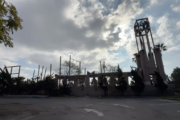Los Angeles police officers killed a man on Skid Row on Sunday night, shooting him outside the building where I work. He died, his body broken, as others’ have been, just a few feet from my office.
Surveillance video showed the police officers’ confrontation with the homeless man, known as Africa on Skid Row. The wall on the right of this video is part of a chapel where we were preparing to have a graduation ceremony for men just like Africa—men who have been abused by countless systems and who are often plagued by addictions that are the result of the stressors our negligence imposes on certain groups. In other words, their illnesses are our illnesses too.
As a chaplain overseeing an addiction and homelessness recovery program on Skid Row, I offer here a brief reflection—a public plea, if you like—as an antidote to the collective finger-pointing that will likely follow the conflicting backstories that will emerge to explain Africa’s death. This new chapter in the long, mostly disheartening story of Skid Row quite rightly should be added to the larger chronicle of highly publicized killings of black bodies at the hands of police across the country.
On the morning following the shooting, we processed our loss in the classes I teach in our community—a community resonating with and trying to believe in the voices chanting for justice on the street just outside our building. As a still naive, still blindingly privileged white man, I was shocked to realize that while my students felt grief, they felt no shock of their own.
For men living in this and other racialized, criminalized spaces in L.A. and around the country, Africa’s death was a drop in a sea of memories of violence that seldom attracted a passing glance from anyone else in the wider world—broken bodies with no cell phone record, no news coverage.
Since the mid 1970’s, we—as citizens of Los Angeles—have opted for a policy of “containment” on Skid Row. We’ve consolidated services and resources into a few blocks, a product of our vigilant “Not in My Backyard” (NIMBY) approach to the problem.
The complexities of gentrification and the vigilant protection of the more capitalistically productive manufacturing and entertainment districts surrounding Skid Row have produced a regime of that enforces the rigorous policing of minor infractions such as jaywalking and littering in order to deter larger crimes (a so called “broken windows” strategy). Codified in the “Safer Cities Initiative”—of which the officers involved in Africa’s shooting were a part—the accumulation of tickets for minor infractions yields warrants and subsequent incarcerations into the already flooded penal system. This de facto criminalization of homelessness in the tonier parts of downtown has contributed greatly to the enmity between Skid Row residents and law enforcement.
While there have been a few gestures toward a more progressive approach, we’ve essentially doubled down on containment strategies against “lawlessness” rather than develop strategies to address the root causes of homelessness. The deep, systemic belief that the lives of the human beings contained in this modern-day ghetto are affronts and impediments to the surrounding commercial revitalization implicates us all. It is within this context that Africa’s death must be understood.
This story is not just about the use of lethal force against one man’s body, but also about the lethal force we collectively place on the people of Skid Row by sequestering them in a zone of confinement and tasking officers with the job of policing its boundaries.
This is not just about the violent death of this body, on this corner, outside of my chapel, but the social death this body and thousands of others face every day, as we focus our energies on keeping them “out of our backyards.”
It is not just about the judgments we pass on a man’s actions in a 15-second confrontation with police, but the judgments we’ve passed on that man over the course of his entire life.
This is an opportunity to meditate on the value of a life that has only been racialized, confined and policed, a life whose value has been weighed against ours and found to be disposable. A life and a body that represents many lives and bodies that have been criminalized, confined, discarded and forgotten.
The containment of policed bodies is thus the narrative that frames the encounter between the police and a black man living in a tent on Skid Row. It’s important to see that we, not merely those tasked with the enforcement of this policy of containment, have created this grim reality in the very heart of our city.
Whatever you think as the reports come in, please don’t make this story about ballistics, Africa’s felony record or any other detail that helps us behave like armchair observers that a story that doesn’t really concern us.
Instead, make this story about creating a world in which the men who happened not to be killed in this incident—the men inside the chapel on the day Africa was shot—can feel shock and outrage again. This should be the story that prompts us to change the bigger story in which Africa’s death is just one more life cast aside and forgotten.
Make this story about making their bodies and lives matter as much as yours.
Jonnie Russell is a contributing fellow with the USC Center for Religion and Civic Culture.







